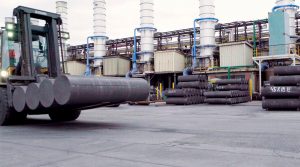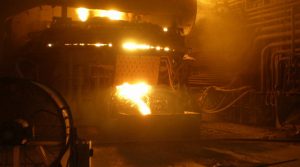Em 2006 fui trabalhar em um produtor de aços com usinas no Brasil. Acabei sendo convidado para ir trabalhar nos EUA. Como minhas atribuições iam além de simplesmente otimizar consumo de eletrodos de grafite, elaborei uma lista de itens a verificar no EAF da planta norte americana.
Segue abaixo a lista que elaborei, (um pouco chata de ler, reconheço) como exemplo do tamanho de minha preocupação com a tarefa que me esperava por lá;

REMINDER LIST
EAF
Capacity:
TRAFO
Charge
% Scrap
%DRI
LIME (kg)
Carbon(kg)
Lining Life
Delta life
How is Carbon charged into the EAF?
Anthracite/Coke thru basket or injection?
What kind of Carbon addition is used?
How many kg/ton?
Taps Heat stage/minutes Secondary Current kA Tap voltage/Arc length
Electrodes: size x length x nipple size
Operational Indexes:
Electrodes Consumption – kg/ton and g/kW?
Energy Consumption – kWh/ton?
Productivity (tphour)
Refractories Consumption – Kg/ton?
Tap to Tap
Power On
Oxygen Nm3/t
Burners –
How many
Oxygas or Oxyfuel
How many MW each
Gas consumption (Nm3/ton)
Energy Consumption – kWh/ton?
Oxygen lances at the door?
How many lances?
When they start/end blowing?
COJETS or similar?
How many?
Where?
How many MW each?
Melting Programs
Taping temperature?
Characteristic Curves:
Available Taps + Respective Curves + cos φ + Arc Length:
Foamy Slag Practice – How is the process?
Heats Yield?
EAF general condition:
Arms:
Clamps:
Regulation system/mechanism:
Control Panel at EAF cockpit:
How reliable/good are the readings on the instruments panel?
Electric grounding – How good is it?
Is there a PC management for heats? What are the power programs?
Steel Shop:
Lay –Out?
Scrap Yard?
Lay –Out?
Buckets Loading
DRI
Physical and Chemical Characteristics:
How much is the Fe content?
%
Volume
%C
%SiO2
Others:
Diameter Sizes Distribution:
% and mm
How is it charged into the EAF?
5th hole:?
Position of 5th hole:?
Where does the DRI falls inside the EAF?
When it starts to ad DRI on each heat? Why?
Is there any control equipment installed by a GEs supplier?
How it can be used to improve EAF operations?
Who are the local Technical assistance for GEs?
Name;
Phone:
Email:
POWER OFF TIME COMPOSITION:
Time for dumping a bucket charge into the EAF:
Time for:
Temperature acquisition:
Sampling acquisition:
Columns exchange:
Pieces amendment on columns if on top of the EAF; (VERY DANGEROUS PROCEDURE)
Operational delays:
High scrap:
Bad positioning of Roof:
Waiting for bucket to charge:
Problems with DRI feeding system:
How it is made the t/hour DRI feeding control?Preventive maintenance stops:
Corrective maintenance stops:
How it is built the primary and the secondary circuit for the EAF:
Get the project/drawing:
LF
TRAFO MVA:? MW:?
Electrodes size (Diameter x length)
Taps Time Taps Current kA Taps Voltage/Arc length
Ladle’s dimensions (internal) Diameter x Height
Free Board height:
Slag Line height?
Power-On:
Power-Off:
How are the alloys added?
Is cored wire used? Kind/supplier
For what kind of alloys?
Magnetic or gas bubbling stirring?
Porous Plug life?
Slide Gate life?
Ladle’s life?
Main cause of ladle’s death?
REFRACTORIES:
Consumption index in kg/ton of good billet?
EAF:
Gunning?
Who is the main supplier?
How is it purchased?
Storage condition?
Life of:
Consumable Oxygen Lance:
Cooled Oxygen lance?
EAF Delta?
Cooled EAF panels?
FIRST MOVEMENT:
Lay-Out and flowsheet:
GEs – From reception to steel shop;
Scrap – From reception to EAF;
DRI – from source to EAF;
Alloys – from reception to steel shop
EAF
LF
Understand the flow & pin point the problems.
SECOND MOVEMENT:
Observe the EAF regarding:
CHARGING OF:
Scrap
DRI
Alloys
Carbon Injection
Oxygen Injection
Burners use
Lances use
COJETS use
Foamy Slag process
Timing during the heat sequence?
Slag removal from EAF, during heat:
Heat ending?
Taping
Inclination?
Temperature acquisition?
Sampling Acquisition?Remarks:
Compare the approved power program with the one in use and pin point the differences;
Ladles:
Temperature?
Condition?How much time takes the ladle to receive the tapped steel and to reach the LF station?
What operations are made, during this time, on the ladle?
Alloys addition?
Gas bubbling?
Is there a gap between the ladle and its roof?
If any, how big is it?
THIRD MOVEMENT:
Issues that increase the electrodes consumption seminar;
Training at work site;
Antônio J. G. Candiota – Jun/2007
Isso foi em 2007.
Quando se fala em eletrodos de grafite e sua otimização de consumo, estamos falando da operação do EAF e do treinamento do pessoal que opera o EAF e monta as colunas. TUDO conta! Na realidade, para os eletrodos conta desde sua recepção na usina.
Aí a turma que foi treinada ou sai da empresa ou é promovida e o ciclo de treinamento recomeça, ou então perdemos a mão sobre o EAF e sobre o consumo dos eletrodos. O simples fato de existirem padrões operacionais não é suficiente para garantir que tudo será executado como está no papel. E é aí que eu começo a ver a geração 4.0 de operação industrial como a grande saída para manter padrões operacionais em alto nível…



